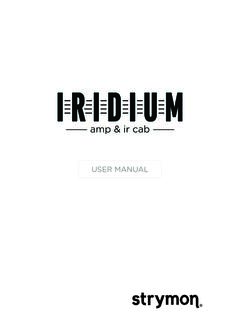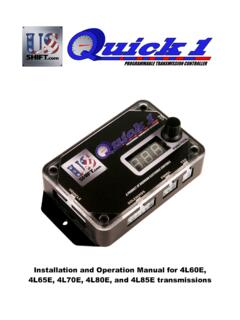Transcription of CONTROL SYSTEMS LAB Laboratory Manual
1 MUFFAKHAM JAH COLLEGE OF ENGG&TECH, ROAD NO3, BANJARAHILLS, HYD -500034 MUFFAKHAM JAH COLLEGE OF ENGINEERRING AND TECHNOLOGY Road , Banjara Hills, Hyderabad, Telangana state Programs: (Electrical and Electronics Engineering) & (Electronics and Instrumentation Engineering) CONTROL SYSTEMS LAB Laboratory Manual PREPARED BY P. BHARATHI, , ELECTRICAL ENGINEERING DEPARTMENT CONTROL SYSTEM LAB (EE332) III/IV, EEE & EIE 2 MUFFAKHAM JAH COLLEGE OF ENGG&TECH, ROAD NO3, BANJARAHILLS, HYD -500034 CONTROL SYSTEM LAB (EE332) III/IV, EEE & EIE 3 MUFFAKHAM JAH COLLEGE OF ENGG&TECH, ROAD NO3, BANJARAHILLS, HYD -500034 LIST OF EXPERIMENTS CONTROL SYSTEMS LAB(EE332) 1.
2 Characteristics of DC Servomotor. 2. AC Position CONTROL system. 3. DC Position CONTROL system. 4. ON/OFF Temperature CONTROL system. 5. Step response of second order system. 6. Characteristics of AC Servomotor. 7. Characteristics of synchro pair . 8. Frequency response analysis of LEAD compensating network 9. Frequency response analysis of LAG compensating network CONTROL system using PID. 11. Level CONTROL system. 12. Step response and frequency response of a given plant CONTROL SYSTEM LAB (EE332) III/IV, EEE & EIE 4 MUFFAKHAM JAH COLLEGE OF ENGG&TECH, ROAD NO3, BANJARAHILLS, HYD -500034 ELECTRONICS AND INSTRUMENTATION ENGINEERING EE 332- CONTROL SYSTEMS LAB INDEX Serial No Name of the experiment Page No 1.
3 Characteristics of DC Servomotor. 5 2. AC Position CONTROL system. 9 3. DC Position CONTROL system. 12 4. ON/OFF Temperature CONTROL system. 17 5. Time domain analysis of second order system. 20 6. Characteristics of AC servomotor. 24 7. Characteristics of synchro pair 28 8. Frequency response analysis of LEAD compensating network 32 9. Frequency response analysis of LAG compensating network 36 10. Temperature CONTROL system using PID 40 11. Level CONTROL system. 44 12. Step and Frequency response analysis of a plant 48 CONTROL SYSTEM LAB (EE332) III/IV, EEE & EIE 5 MUFFAKHAM JAH COLLEGE OF ENGG&TECH, ROAD NO3, BANJARAHILLS, HYD -500034 EXPERIMENT 1 CHARACTERISTICS OF DC SERVOMOTOR Aim: - To find speed-torque characteristic of servomotor.
4 Apparatus: - servomotor set up, multimeter, connecting wires. Theory: A motor can be controlled by varying either the field current o the armature current. The types of servomotors are series motors the shunt motors and the permanent magnet (PM) motor. These motors offer higher efficiency than an motor of the same size, but radio frequency interference is a problem in some applications. In its general form of construction the separately excited motor is similar to the series motor, but armature and field circuits are separated, CONTROL being applied either to armature or field. Field CONTROL may utilize connection of the amplifier single ended or more frequently push-pull, requiring the centre tapped arrangement. An advantage is gained over the series connection in avoiding the larger currents required to drive the armature.
5 The field power is only a small fraction of the armature power, which implies a power gain in the system. The field CONTROL machine requires a constant current supply to its armature, often approximated by a constant voltage connected through a high external series resistance. This device, which is relatively simple and inexpensive, leads to some waste of power in resistance drop and possibly, problems of heat dissipation, but in small machines this is usually unimportant. The closeness of the approximation depends on motor running at low enough speeds for the armature back emf to be small compared with the supply voltage. Armature CONTROL , though it requires higher current handling and current reversal, provides a nearly ideal linear performance. This linearity is achieved through excitation of the field under fixed condition, so that magnet type characteristics is not imposed on the machine.
6 More over as the armature circuit posses a similar time constant than the field, a faster response can be obtained. It is noteworthy that the constant field connection gives machine performance equivalent to the permanent magnet motor. CONTROL SYSTEM LAB (EE332) III/IV, EEE & EIE 6 MUFFAKHAM JAH COLLEGE OF ENGG&TECH, ROAD NO3, BANJARAHILLS, HYD -500034 Block Diagram Of DC Servomotor Procedure:- Armature CONTROL : 1. Adjust T1 at setting with the help of knob K. 2. Ensure the POT P1 (speed CONTROL ) is in the maximum anti clock wise position. Switch on supply. 3. Connect a digital or analog Multimeter across the terminals marked armature to measure armature voltage in the range volts. 4. Adjust P1 and P2 so that Va= and Vf= volts. 5. Note down T1, T2 and speed and enter the results in the table 1.
7 6. Adjust T1 up to in the steps of to get a set of readings. 7. Now for Va= volts etc repeat step no 6. 8. From table no 1, plot the speed torque characteristics. CONTROL SYSTEM LAB (EE332) III/IV, EEE & EIE 7 MUFFAKHAM JAH COLLEGE OF ENGG&TECH, ROAD NO3, BANJARAHILLS, HYD -500034 FIELD CONTROL METHOD 1. You may repeat above steps for various values of field voltages by controlling POT P2 and keeping Va at volts. Table 1: For Armature CONTROL Radius of pulley=R= Field voltage Vf =16v Armature voltage Va=13v T1 gm T2 gm T1-T2 gm Torque (T1-T2).R N( ) Ia Amp Table 2: For Field CONTROL Field voltage Vf =16v Armature voltage Va=15v T1 gm T2 gm T1-T2 gm Torque (T1-T2).R N( ) Ia Amp CONTROL SYSTEM LAB (EE332) III/IV, EEE & EIE 8 MUFFAKHAM JAH COLLEGE OF ENGG&TECH, ROAD NO3, BANJARAHILLS, HYD -500034 Precautions: 1.
8 The speed CONTROL knob should be always in the most anticlockwise position before switching on the equipment. 2. In order to increase the armature voltage, rotate the knob in the clockwise direction in a gentle fashion. 3. In order to increase the load on the servomotor adjust the knob . Result: Torque-speed characteristics of Servomotor at different Armature voltages and Field voltages are plotted. CONTROL SYSTEM LAB (EE332) III/IV, EEE & EIE 9 MUFFAKHAM JAH COLLEGE OF ENGG&TECH, ROAD NO3, BANJARAHILLS, HYD -500034 EXPERIMENT NO: 2 AC POSITION CONTROL SYSTEM Aim: To study position CONTROL system. Apparatus: position CONTROL system unit. Theory: - A pair of precision servo potentiometers is working as an error detector. The potentiometer marked as INPUT potentiometer translates information regarding the desired angular position into a proportional voltage.
9 The potentiometer marked OUTPUT potentiometer converts the information regarding the present position of mechanical load into a proportional voltage. Note that this pair of input And output potentiometers is excited by a 6 volts 50 Hz supply. {V {t}}. Any difference of potential between the wiper contacts of servo potentiometer is amplified by means of power amplifier. The power amplifier output activates the CONTROL winding of the servomotor {2 phase}.The other is activated {reference winding} by means of fixed AC voltage. The load to be positioned is coupled to the output shaft of the output servomotor and gear train combination. The same shaft is also coupled to the output potentiometer . This position CONTROL system works to make the output shaft position identical to the input shaft position. When the output shaft is being positioned, the mechanical load is also moved to a new desired position thus making error voltage always zero.
10 The system works to make the error voltage zero after disturbance. Block diagram of position CONTROL System: CONTROL SYSTEM LAB (EE332) III/IV, EEE & EIE 10 MUFFAKHAM JAH COLLEGE OF ENGG&TECH, ROAD NO3, BANJARAHILLS, HYD -500034 Procedure:- 1. Switch ON the AC main supply, Switches SW1, SW2 and SW3 should be in the ON position. 2. Observe that the input and output potentiometers come in alignment. 3. Keep the gain pot in almost in maximum gain position { Almost fully clockwise position} 4. Take the input potentiometer to the starting position very near to the zero position. The output potentiometer will also follow the input potentiometer till the null indicator indicates null position. 5. Enter the observations in the tabular column given below. You may repeat the observations with lower amplifier gain, to observe that there is greater error, with higher gain { maximum gain} you may note that the output pot indicates sustained oscillations.










